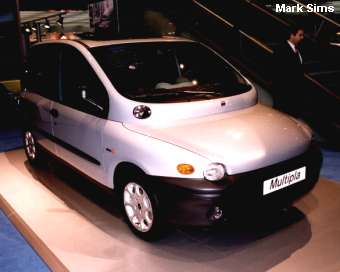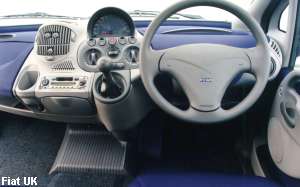
|
|
| NEWcars: 2000 Fiat Multipla, 11 December 1999 |

|

|
Story by Fiat: (Dec 99)
INTRODUCTION Fiat has an unrivalled history of producing groundbreaking and innovative vehicles, especially those which maximise internal space for their occupants. Starting with the 1930s 'Topolino', the list includes the Fiat Cinquecento, the original Multipla of 1956, the 127, Panda, Uno, Bravo/Brava and new Punto. |
|
The design brief of the new Multipla posed an interesting challenge to Fiat's designers and engineers: how to bring affordable, spacious and versatile motoring to middle income families - and to do it properly, without compromising important criteria. Specifically, the design brief was for an MPV no more than 4 metres long (less than a Fiat Bravo) with the following capabilities:
|
|

|
The spaceframe Instead of the conventional bodyshell that's pressed from a single piece of steel, the spaceframe is a 'latticework' of steel sections, which are linked so as to form the skeleton of the car. The sheet metal that comprises the bodywork - which can be of varying thicknesses - is then welded to this 'skeleton'. |
|
The benefits are numerous:
A radical cabin rethink Other manufacturers have side-stepped the issue by installing rear seats that are only suitable for children, or by providing negligible luggage space, or by restricting the seating to five individuals. This is only to be expected, since their offerings are really only bigger-bodied versions of existing five-door hatchbacks. Fiat's response, however, was to face the issue head on and completely rethink the MPV's interior design. Radical solutions include:
|
|
|
The Twin Module approach Twin Module means there are two separate 'levels' to the vehicle - a lower, streamlined level, and an upper one which is unusually tall and voluminous. They appear to be laid one upon the other, thus avoiding the inevitable waste of space that occurs when the windscreen and bonnet are designed to join on the same plane. The Twin Module approach also accounts for Multipla's unusual and striking exterior styling that makes it quite unlike any other car on the roads today. |

|

| [This Week] [Full Contents] [News] [Features] [Car of the Week] [Motorsport] [A-Z] |